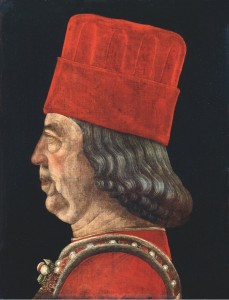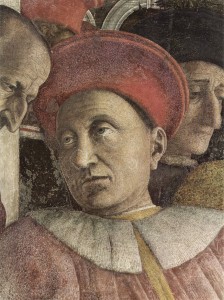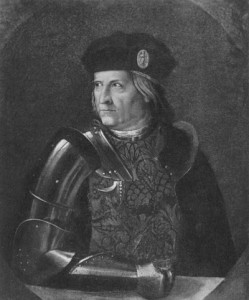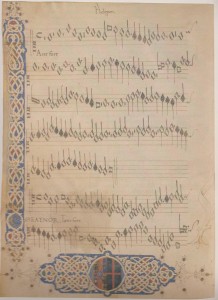A history of the trombone in timeline form. For sources see Trombone History Bibliography.
_______________
c. 1400—The earliest trombones, according to some scholars, appear in northern Italy and southern France (Eliason). According to other scholars, it is more likely, based on performer nationalities and manufacturing locations, that the trombone originates in Germany (Herbert, Susato 117; Polk, Archival Documents).
1400-1420—According to Polk, “The trombone, though not yet universal, [becomes] an accepted fact of the musical scene in the first few decades of the fifteenth century” (Polk, German 66).
Early 1400s—In German cities, according to Polk, “In the first decades of the fifteenth century the artistic energies of the civic wind players were centred on performance on shawms and trombone. Playing of other instruments may have been called for, but such doubling was distinctly secondary” (Polk, German 113).
 1403—Braunschweig, Germany: City records indicate a salary payment to 2 shawms and a trombone (2 piperen unde enen bassuner) (Polk, Archival Documents).
1403—Braunschweig, Germany: City records indicate a salary payment to 2 shawms and a trombone (2 piperen unde enen bassuner) (Polk, Archival Documents).
1405—Braunschweig, Germany: City records show a salary payment to 2 shawms and a trombone (2 piperen unde 1 bassuner) (Polk, Archival Documents).
1407—Siena, Italy: German musician Angelo d’Arrigo joins the Palace trumpeters as a player of tuba grossa. There is speculation that this term, tuba grossa (Latin: large trumpet), could be a scribe’s best effort at describing a trombone, which would have been a very new instrument at the time (D’Accone, Civic Muse 443, 517).
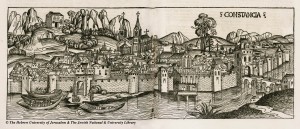 1414-18—Konstanz, Germany: At the Council of Constance, as a preliminary to the investiture of Frederick of Nuremberg as Elector of Brandenburg, all the Posaunen and all the Pfeiffen parade through the streets of the city (Galpin, The Sackbut). At the same council, an English delegation under Richard Beauchamp, Earl of Warwick, arrives with 3 trombonists (pusauner) and 4 shawmists; the trombonists “played in three parts, one above the other, as one usually sings” (Strohm 108; Whitwell, Before 263). In addition, the Pope arrives with an ensemble of shawms and trombones playing in “wild discord” (Whitwell, Before 81). As with the other references to trombone (or posaune) up until around the middle of the 15th century, these references may be to a single-slide instrument (i.e., slide trumpet) rather than a double-slide instrument like the modern trombone.
1414-18—Konstanz, Germany: At the Council of Constance, as a preliminary to the investiture of Frederick of Nuremberg as Elector of Brandenburg, all the Posaunen and all the Pfeiffen parade through the streets of the city (Galpin, The Sackbut). At the same council, an English delegation under Richard Beauchamp, Earl of Warwick, arrives with 3 trombonists (pusauner) and 4 shawmists; the trombonists “played in three parts, one above the other, as one usually sings” (Strohm 108; Whitwell, Before 263). In addition, the Pope arrives with an ensemble of shawms and trombones playing in “wild discord” (Whitwell, Before 81). As with the other references to trombone (or posaune) up until around the middle of the 15th century, these references may be to a single-slide instrument (i.e., slide trumpet) rather than a double-slide instrument like the modern trombone.
1417—Ofen, Hungary: Emperor Sigismund holds an assembly where he is reportedly accompanied by a wind band of 86 shawms and trombones (Whitwell, Before 244).
1418—Paris, France: Among musicians listed in the service of Charles VI is a trompete pour menestrier (as distinct from “war trumpet”), possibly an early term referring to trombone (Perkins, Musical Patronage).
 1419—Hildesheim, Germany: City payment records indicate salaries for des rades piperen, in addition to payment for des basuners syden banre (the trombonist’s silk banner) (Polk, Archival Documents).
1419—Hildesheim, Germany: City payment records indicate salaries for des rades piperen, in addition to payment for des basuners syden banre (the trombonist’s silk banner) (Polk, Archival Documents).
1421—Nuremberg, Germany: Accounts indicate that musicians of the court of Margrave of Brandenburg include a 4-part shawm band with trombones (posaunen). The musicians in the account are referred to separately: first, 2 trumpets (“2g…trummetern”), then a 4-part shawm band with trombone (“4 g. markgraf Fridrichs pusaunern und pfeiffern”). Thus, according to historian Keith Polk, “This document carries particular authority with its reference to both ‘trummeten’ and ‘posaunen'” (Polk, German 66).
1428—Hildesheim, Germany: City payment records include the following entry: “dem nigen basuner unde dem bumharde te dranckgelde” (“to the new trombonist and bombard player for drink money”) (Polk, Archival Documents).
1428—Hildesheim, Germany: City payment records include the following entry: “der rades piperen to hulpe…do se na enem nigen basunere gin” (“to the city pipers…as they went to find a new trombonist”) (Polk, Archival Documents).
1429—Hildesheim, Germany: City payment records include payment to “the new trombonist and bombard player for drink money (“dem nigen basuner unde dem bumbarde te dranckgelde”) (Polk, The Trombone).
c. 1430—The alta ensemble’s most likely instrumentation, according to Polk, is tied to contrapuntal function and follows the description of Tinctoris: shawm (soprano), bombard (altus), bombard (tenor), and trombone (bass). This instrumentation remains constant “for a century or more, from c. 1430 to well beyond 1520” (Polk, German 83).
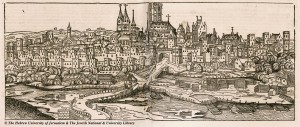 1438-1460—Munich, Germany: During the reign of Duke Albrecht III of Bavaria, the duke’s shawm band probably consists of 3 shawms and 1 trombone (Polk, German 99).
1438-1460—Munich, Germany: During the reign of Duke Albrecht III of Bavaria, the duke’s shawm band probably consists of 3 shawms and 1 trombone (Polk, German 99).
1439—Ferrara, Italy: The earliest known reference to the word trombone is made, applying the Italian suffix one (large) to tromba (trumpet). The document mentions a “tuba ductili…trombonus vulgo dictus” (Polk, Archival Documents; Kurtzman, Trombe).
1440-1493—Vienna, Austria: Emperor Friedrich III supports alta ensembles consisting of 5 players: 3 shawms and 2 trombones (Polk, German 88).
1443—Florence, Italy: A German trombonist is hired for the town wind band (pifferi). The superiority of foreign instrumentalists is an accepted fact in Italy: this same year, officials in Florence actually pass a motion that only foreign musicians may be members of the pifferi (Polk, Foreign 326; McGee, Service).
1444—Florence, Italy: The Signoria (city government) employs a wind band of 3 shawms and 1 trombone (D’Accone, Civic Muse 526).
1444—Florence, Italy: A scribe, apparently struggling to find a name for a relatively new instrument in the court shawm band, calls the trombone a “tortuous trumpet” (tube tortuose—literally having repeated twists or bends). In another document he terms it a tuba retorta, and finally, a tuba grossa e torta (Polk, Epilogue).
 1445—Florence, Italy: An account describes the trombone as “trombon grosso…che e tromba torta” (a “large trombone…that is a twisted trumpet”) (Polk, Foreign 326; Polk, Archival Documents).
1445—Florence, Italy: An account describes the trombone as “trombon grosso…che e tromba torta” (a “large trombone…that is a twisted trumpet”) (Polk, Foreign 326; Polk, Archival Documents).
1446—Siena, Italy: City officials elect to form a Palace wind band, or pifferi, and send the following invitation to Maestro Garino of Avignon: “Esteemed friend! Having learned of your talents and of your mastery of wind instruments, and desirous of having you in our service, we have, together with our colleagues, nominated you and two other pifferi and a trombone, whom you will choose, for a lifetime [appointment in our Palace], at the salary which will be appended here in the hand of our government’s notary. Thus, if you decide to enter our service at that salary, we ask that you bring two good pifferi and a trombone with you and that you come to Siena as soon as you possibly can. You will be welcomed warmly and will be treated so well by us that you will praise our city to the skies.” The salary offered is comparable to salaries in Florence and twice that of the Palace trumpeters, and the invitation is accepted (D’Accone, Civic Muse 522).
1446—Siena, Italy: A document identifies the word trombone as an Italian version of the Latin augmentative tubicinone (D’Accone, Civic Muse 517). Specifically, the priors (city rulers) decide that a person who plays “a large trumpet, commonly called a trombone” can have a lifetime appointment at the Palace (D’Accone, Civic Muse 522).
1446—Oudenaarde, Belgium: A trombonist by the name of Janne de Brecht is appointed to a post with the town wind band, where he serves until 1497 (Polk, Susato 88).
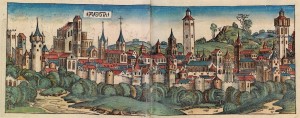 1447—Augsburg, Germany: Trombone is mentioned as part of a civic wind band (Polk, German 112).
1447—Augsburg, Germany: Trombone is mentioned as part of a civic wind band (Polk, German 112).
1447—Siena, Italy: New clothing for Assumption Day performances is authorized for several of the city’s wind band (pifferi), including trombonist Giovanni della Magna (D’Accone, Civic Muse 524).
1447—Siena, Italy: Maestro Giovanni da Alamania is hired as trombonist with the Palace wind band, where he continues to work until 1456. He is mentioned several times in subsequent documents. In September of 1449 he is fired, then quickly rehired two months later. In 1450 he is granted leave to travel to Rome to seek an indulgence (D’Accone, Civic Muse 786).
1447—Siena, Italy: A document records the decision “to have another silver trombone [trombone d’argento] made for the commune, similar to the one that is played with the pifferi” (D’Accone, Civic Muse 553).
1449—Siena, Italy: A group of musicians from Florence performs for Assumption Day festivities. The group includes 6 trumpeters, a trombonist, and a herald (D’Accone, Civic Muse 687).
1449—Siena, Italy: The Concistoro decrees, “Maestro Ians, who plays the trombone, could no longer serve the Palace because he had behaved dishonorably” (D’Accone, Civic Muse 524).
c. 1450—Berlin, Germany: The Brandenburg court includes a wind band of 3 shawms and 2 trombones (Polk, German 100).
c. 1450—Dijon, France: The Burgundy court includes a wind band of 3 shawms and 1 or 2 trombones (Polk, German 100).
 c. 1450—Naples, Italy: The court ensemble includes 3 shawms and a trombone. It performs at weddings, banquets, public and civic ceremonies, in the church, and even on the battlefield (Atlas, Music 110).
c. 1450—Naples, Italy: The court ensemble includes 3 shawms and a trombone. It performs at weddings, banquets, public and civic ceremonies, in the church, and even on the battlefield (Atlas, Music 110).
1450—Siena, Italy: The pifferi and trombones (tromboni) are given leave to pilgrimage to Rome (D’Accone, Civic Muse 556).
1450—Siena, Italy: A wind band from Florence visits Siena for August festivities. The group consists of three shawms and a trombone (D’Accone, Civic Muse 525).
1450—Siena, Italy: A trombonist from Lucca, Italy (“uni tromboni qui venit ex Luche”) performs at Assumption Day festivities in Siena (D’Accone, Civic Muse 687).
1450—Leuven, Belgium: The city employs a wind band of 3 shawms and a trombone. Originally a group of town “watchers,” the group’s function gradually becomes primarily musical (Polk, Susato 83).
1450—Lucca, Italy: Several trumpeters and a trombonist from Lucca visit Siena for August festivities (D’Accone, Civic Muse 525).
1450—Ypres, Belgium: The city employs a wind band of 2 shawms and a trombone (Polk, Susato 87).
1450—Nördlingen, Germany: Trombone is mentioned as part of civic band (a shawm band) (Polk, German 112).
 1450—Brussels, Belguim: The city has a 3-part wind ensemble that includes 2 shawms and a trombone (Polk, Susato 82).
1450—Brussels, Belguim: The city has a 3-part wind ensemble that includes 2 shawms and a trombone (Polk, Susato 82).
1451—Siena, Italy: Agostino di Piero da Albania is engaged as a new trombonist with the pifferi (civic wind band) (D’Accone, Civic Muse 525).
1451—Verona, Italy: Records show payment for the performance of a trombonus tectonicus (Polk, Archival Documents).
1452—Siena, Italy: The priors (city rulers) grant Agostino di Piero da Albania, who was hired as a trombonist one year earlier, a leave to visit Venice for a month. They also stipulate that, should Agostino overstay his leave, he will receive no salary (D’Accone, Civic Muse 525).
1454—Siena, Italy: A clothing list for Assumption Day and Christmas performances lists 3 pifferi and a trombone (the German trombonist Maestro Giovanni, listed as Maestro Giovanni trombone) (D’Accone, Civic Muse 526).
1455—Siena, Italy: The priors (city rulers) appoint a new trombonist, Arrigo di Giovanni da Francoforte, at the relatively high salary of L. 16 per month. By contrast, Santi di Pavolo enters palace service the same year as a trumpeter at the considerably lower salary of Fl. 2. This trumpet player moves to the pifferi (civic wind band) a few years later as a trombonist and receives a considerable raise (to L. 14 per month) (D’Accone, Civic Muse 529, 534)
1456—Bruges, Belgium: 4 new civic musicians are hired and termed the “minstrels of the city.” The ensemble probably consists of 2 shawms, a bombard, and a trombone (Polk, Susato 75).
1456—Ferrara, Italy: Duke Borso d’Este maintains a musical household of one trombone, 5 trumpets, 2 shawms, 5 keyboards and strings, and one singer (Whitwell, Before 199). The wind band, a subset of this group, consists of 2 shawms and a trombone. The trombonist, a player by the name of Agostino, earns a yearly salary comparable to trumpeters and other musicians of court (Lockwood 178).
1456—Siena, Italy: A group of musicians from Florence, Italy performs for Assumption Day festivities. They include 4 trumpeters, a shawmist, 4 pifferi, and a trombonist (D’Accone, Civic Muse 688).
1457—Siena, Italy: Payments to musicians at Palio festivities include piffari e trombone (D’Accone, Civic Muse 707).
1458—Nuremberg, Germany: The Duke of Saxony visits Nuremberg, bringing with him the following musicians: “4 trummeters, 3 pfeiffer und 2 posaunen.” Historian Keith Polk points out that these musicians likely comprise two different ensembles: “one a band of four natural trumpets, the other a shawm band consisting of three shawms and two trombones” (Polk, German 59).
1458—Siena, Italy: A clothing list for an Assumption Day performance by the pifferi (civic wind band) includes 3 shawm players and 2 trombone players (D’Accone, Civic Muse 529).
1459—Ghent, Belgium: Trombonist Jehan Bremer of Tournai is hired as a member of the civic wind band (Polk, Susato 79).
1459—Florence, Italy: An outdoor ball is hosted by Cosimo de’ Medici on the occasion of an important state visit of the heir to the duchy of Milan, Galeazzo Maria Sforza. A chronicler of the events describes the music and dancing at the ball: “That was the time when the shawms and the trombone [tronbone] began to play a saltarello artistically designed in all its proportions. Then each noble and nimble squire took a married lady or a young girl and began to dance, first one, then the other. Some promenade around, hop, or exchange hands, some take leave from a lady while others invite one, some make up a beautiful dance in two or three parts” (Nevile, Eloquent 150; Nevile, Measure; Sparti 135; Gombosi, About Dance). Earlier in the narrative, the chronicler notes the place reserved for the shawm and trombone players: “Opposite the seigniorial coat of arms above the fence, a place was prepared high up for the shawm and trombone players [pifferi & tronbone]” (Nevile, Eloquent 144). He then records the actual arrival of the shawm and trombone players, including, in this case, a noteworthy description of the trombone: “It was at this time that I saw the shawm players arrive with the trombone [tronbone di tromba torta, or trombone with bent pipe] and go up to their appointed place” (Nevile, Eloquent 146).
c. 1460—The term sackbut and its variants begins appearing in documents. In French-language areas it apparently replaces the term trompette des menestrels (Polk, The Trombone).
1460s—Augsburg, Germany: The city is temporarily without a trombonist for their civic wind band, but continues to hire a trombonist “for especially important dances” (Polk, German 118).
1460s—Mantua, Italy: Prince Ludovico II Gonzaga begins supporting a wind band that includes pifferi and tromboni (Whitwell, Before 1500 211).
1460—Italy: A group of musicians from Florence performs for Assumption Day festivities in Siena. Included are 11 trumpeters, a percussionist, 3 players of wind instruments, and a trombonist (uno trombone) (D’Accone, Civic Muse 688).
1461—Milan, Italy: Records show that Florentine ambassadors visiting Milan pay tips to eight “trombetti dello Illustrissimo Duca di Milano” and six “pifferi et uno trombone del signore Duca,” among others (Prizer, Music at the Court of the Sforza).
1463—Siena, Italy: A former Palace trumpeter named Santi di Pavolo da Volterra is hired as trombonist with the Siena civic wind band. His new salary is L. 14, significantly higher than his trumpeter’s salary of L. 8.4 (D’Accone, Civic Muse 536).
1463—Mantua, Italy: The arrival of Margaret of Bavaria is announced by an enormous musical ensemble, including a procession of 107 trombi, pifari, tromboni (Atlas, Music 99; Kurtzman, Trombe).
1463—Italy: The civic wind band from Florence, Italy, which includes 3 shawms and a trombone, visits Siena for Assumption Day festivities (D’Accone, Civic Muse 526). The salary for the three shawmists is L. 22.10 per month, while the salary for the trombonist is significantly higher, at L. 30.10 per month (D’Accone, Civic Muse 535).
1463—Siena, Italy: A letter from the Palace wind band members to the Concistoro requests an indirect salary raise: “To our Magnificent and most powerful lords a humble supplication on behalf of your faithful servants, the pifferi and trombone, who having considered their great poverty and misery, and the necessity of providing for their poor families, and having seen that they have no earnings nor provision other than the one they receive from this magnificent Palace, and aware that they have left their own countries and all paternal affection so that they might serve your hallowed Palace, in the service of which they wish always to live and die, beg that it please your most clement lordships to remove the tax [on their salaries], and the portion that has been imposed for the tower that is to be built, [just] as your lordships have deigned to exempt your ushers.” (Despite their claim of “great poverty and misery,” the wind band musicians are relatively well off for their time. Records show, for example, that they are paid better than the palace trumpeters, and many of them own their own homes and vineyards) (D’Accone, Civic Muse 532, 541).
c. 1465—France: An anonymous illustration in Pierre Michault’s La Dance aux aveugles includes what may be a trombone. A related passage from the manuscript says, “From her [Fortune’s] manner she seemed really to be unsettled, or at least unsteady, and also her eyes were blindfolded like the god Cupid. In her right hand she had a royal scepter, and at her left was a wheel, turning continually. On a tall pillar next to her throne there was a man very richly dressed, who had in his hand a silver trumpet [trompete d’argent], which he sounded frequently. And at the foot of the throne there was another man, miserably dressed, who had also a trompette, but this one was made of wood and in a very old style, and it had already seen such long service that it was all used up and broken, though it had been repaired in many places with small cords. With the sound of their trompes these minstrels assembled [the dancers] and had them dance in the presence of their Lady, like many people I have seen in Cupid’s gardens.” The artist of the related illustration may have confused the two instruments described in the manuscript, particularly in light of which one appears to be metal and which is wood (see detail and full image below; public domain).

1465—Naples, Italy: The civic wind band from Naples, consisting of 3 shawms and a trombone (3 piffari et uno trombone), visits Siena for Assumption Day festivities (D’Accone, Civic Muse 526).
 1466—Milan, Italy: The civic wind band consists of 4 pifferi and 2 trombones (D’Accone, Civic Muse 527).
1466—Milan, Italy: The civic wind band consists of 4 pifferi and 2 trombones (D’Accone, Civic Muse 527).
1466—Florence, Italy: Pifferi and trombones are paid to perform at festivities for the wedding of Bernardo Rucellai and Nannina, daughter of Piero di Cosimo de’ Medici (Kemp, Behind the Picture 151).
1467—Nördlingen, Germany: A visiting ensemble called Count Palantine performs with what a local scribe indicates as 3 pfeifers and a trumpet. However, at a performance by the same players in Nuremberg that year, a scribe describes the instrumentation as “three pfeifers and a posaune.” This highlights the elusiveness of terminology in the early years of the trombone’s existence; the instrument is called, depending on context and location, trombone, trumpet, trompette de ménestrels, posaune, sackbut, and various permutations of those terms (Polk, Archival Documents).
1467—Frankfurt, Germany: Bernhard Rorbach mentions a performing group consisting of a lute, chorus of 3 men, and a trombone that is “dampened” (possibly indicating some sort of mute). The same group also performs the following year (Polk, Voices and Instruments).
1467—Siena, Italy: A trombone vacancy in the palace wind band is filled by Frenchman Petro Tristano da Valenza. He begins with a monthly salary of L. 8, but receives a raise to L. 12 within months. Upon the first anniversary of his appointment, he is promised another raise, this one to L. 16, on the condition that he acquire and wear the required uniform worn by the other band members. He apparently refuses to do this, as he is replaced a few months later (D’Accone, Civic Muse 538).
1468—Milan, Italy: 6 trombones, 11 pifferi, and 33 trumpets play for a political gathering (Kurtzman, Trombe).
1468—Bruges, Belgium: At the wedding of Charles the Bold, duke of Burgundy, to Princess Margaret of England, a wind band consisting of trombones, shawms, and bombards performs a motet and chanson to “excellent effect” (Whitwell, Before 1500 235). At the wedding banquet, numerous instrumentalists perform in costume as animals, the trombonist playing the part of a he-goat (Cazeaux 68).
1468—Italy: The civic wind band from Florence, which includes 3 shawms and a trombone, visits Siena for Assumption Day festivities (D’Accone, Civic Muse 526).
1468—Ypres, Belgium: The town expands its civic wind band from 3 to 4 players: 3 shawms and a trombone (Polk, Susato 87).
1469—Heidelberg, Germany: A Corpus Christi procession includes trombones: “…with the bells pealing, and Pusaunen, trumpetten and many pfiffen” (Baines, Brass 108).
1469—Italy: The civic wind band from Florence, which includes 3 shawms and a trombone, visits Siena for Assumption Day festivities (D’Accone, Civic Muse 526).
1469—Siena, Italy: Bartolomeo di Monaldo switches jobs from playing trumpet with the Palace trumpeters to playing trombone with the pifferi (civic wind band) apparently for a considerable raise (D’Accone, Civic Muse 539). He works as trombonist with the Palace wind band until 1486. In 1483 he takes on an additional job as town crier (D’Accone, Civic Muse 781).
1469—Bologna, Italy: A trombone is added to the existing civic wind band of 3 shawms. This instrumentation is maintained through the remainder of the century (D’Accone, Civic Muse 527).
1469—Bologna, Italy: a document describes the “trombonist [trombonen]…who plays with the shawms,” a combination that resulted in consonances that were “suave and delectable” (suavius et delectabilius) (Polk, Patronage and Innovation).
1469—Mantua, Italy: The duke of Mantua maintains a wind band of 3 pifferi and a trombone, a makeup that continues through the rest of the century (D’Accone, Civic Muse 527).
1469—Milan, Italy: Trombonists from Germany or the Low Countries are in the service of the Duke of Milan (Galpin, The Sackbut).
1469—Milan, Italy: By this date, the number of ducal pifferi is expanded to at least 6: 4 shawms and 2 trombones (Prizer, Music at the Court of the Sforza).
c. 1470—Some wind bands in western Europe expand from 4 or 5 parts to 6 parts, with probable instrumentation of 2 shawms, 2 bombards, and 2 trombones (Polk, German 83).
1470—Siena, Italy: The chamberlain sends “the Palace’s silver trombone” to goldsmiths Francesco di Antonio and company for repairs because “it is lacking certain things.” The instrument is to be remade according to a design retained by the chamberlain and to be completed in time for Assumption Day festivities. The agreement also stipulates that, if the goldsmiths require more than the agreed upon amount of silver, it will be supplied by the Palace, in addition to any gold that may be needed for the instrument. The goldsmith later receives payment for gilding the trombone (per doratura del tronbone) (D’Accone, Civic Muse 554).
1471—Ferrara, Italy: Ercole I d’Este becomes Ferrara’s duke, a position he holds until 1505. Charles VIII, king of France, greatly admires Este’s musicians, calling them “I migliori sonatori de piffero, di flauto e di trombone” (“The best players of piffero, flauto, and trombone)” (Murray, New Light).
1471—Italy: Galeazzo Maria Sforza wants to take musicians with him on a trip to Florence; however, because he has imprisoned several shawms and trombones for misbehavior, he is forced to borrow musicians from the marquis of Mantua. Galeazzo writes, “In this our andata to Florence we lack our shawms and trombones [tromboni], whom we had [originally] planned to take with us. We have put them in prison because they committed a certain offense, and, not wishing to free them at present, we ask your Lordship to be pleased to lend us yours for this trip, for which we shall be most grateful.” The request is honored (Broder; Prizer, Music at the Court of Sforza).
1473—Trier, Germany: At a banquet hosted by Frederick III for Charles of Burgundy, entertainment includes music by 2 trombones, 3 trumpets, 4 shawms, and string instruments (Whitwell, Before 247).
1473—Naples, Italy: A delegation visits Naples in order to escort the Princess Eleonora back to Ferrara as the bride of Ercole d’Este. The delegation includes 2 trombones, 2 pifferi, 7 trombetti, an organist, and Pietrobono’s tenorista (Atlas, Music 108).
c. 1474—Asciano, Italy: Matteo di Giovanni’s The Assumption of the Virgin, the center panel of an altarpiece in S. Agostino, includes what may be an angel-trombonist along with several other angel-musicians. The instrument has what appears to be a slide but no visible bell (see detail and full image below; public domain) (Belán 111). Click on full image to expand.
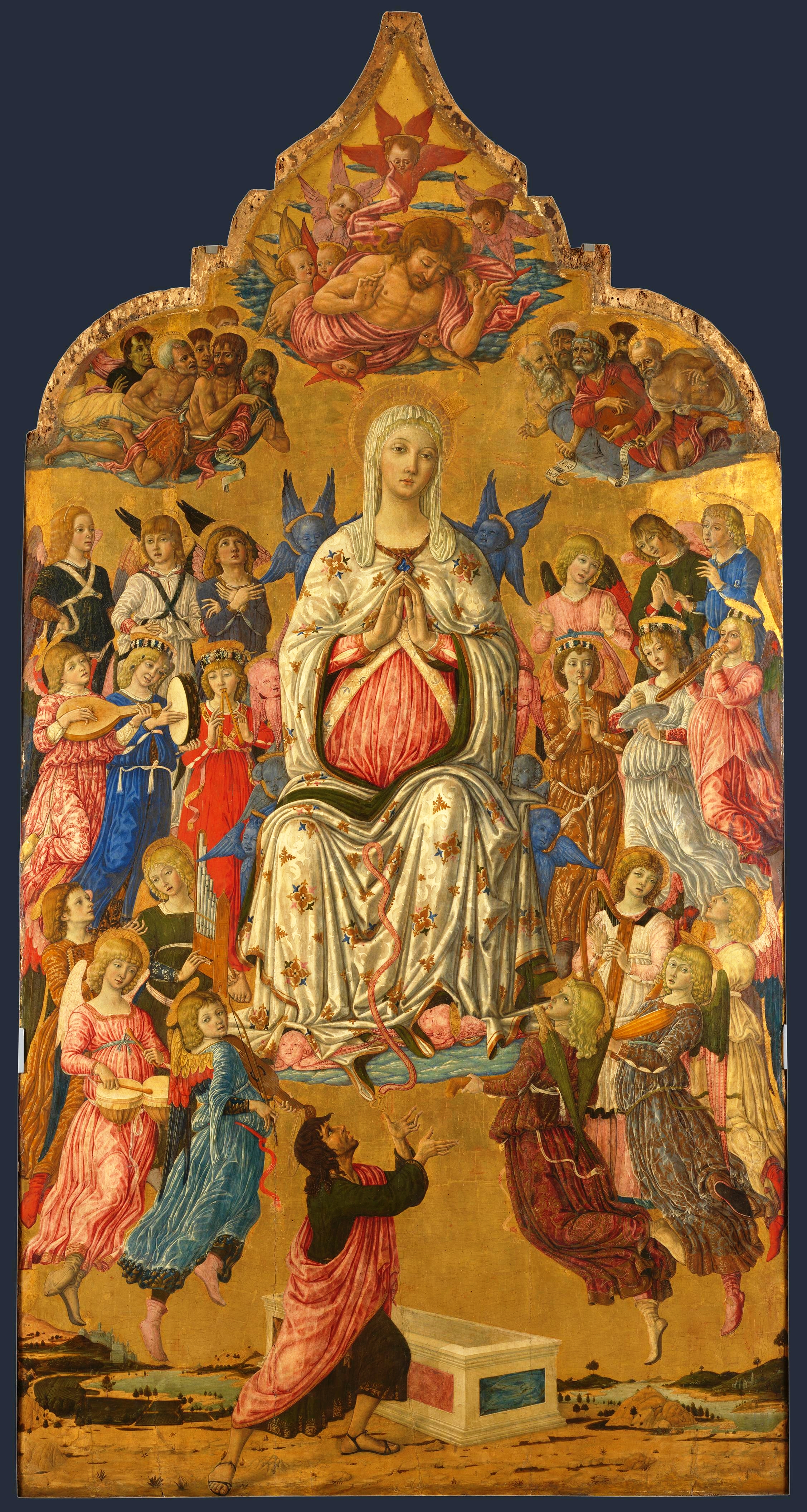
1474—Spain: King Ferdinand employs a trombone (saccabuche) (Baines, Brass 108).
1474—Florence, Italy: The civic wind band continues to include 3 shawms and a trombone. The salary for the three shawms is L. 22.10 per month, the same as 11 years earlier, while the salary for the trombonist, a new player, is somewhat higher at L 24 per month (D’Accone, Civic Muse 535).
1474—Kampen, the Netherlands: A trombonist is hired for regular civic wind band performances: “The sackbut and shawms shall play at the opening and close of all the free markets, and all Saturday evening they shall play the Lof [in honor of the virgin Mary]” (Polk, Susato 90).
1475—Siena, Italy: A trombonist from Lucca performs for Assumption Day festivities (D’Accone, Civic Muse 690).
1475—Mechelen, Belgium: Trombonist Thomas van Lupeghem joins the civic wind band, where he continues to be employed until his death c. 1500 (Polk, Susato 81).
1476—Ferrara, Italy: Court musicicans for the duke of Ferrara’s court include 2 trombones. Listed in salary records are Pietro de Augustino and Zoanne de Alemagna; their pay is comparable to other musicians of the court (Lockwood 180).
1477—Augsburg, Germany: Augustein Schubinger begins his career as a trombonist, although he is also recognized as a player of lute and cornett during various stages of his career (Polk, Voices and Instruments).
1477—Florence, Italy: Antonio de’ Medici is instructed to transfer funds to the Florentine branch of the Medici bank “on behalf of certain trombonists” (D’Accone, Music in Renaissance Florence V281).
1478—Seville, Spain: Ferdinand and Isabella sign a contract to place a 5-member wind band on salary at their court. The ensemble includes trombones (sacabuches): “Don Fernando and Doña Isabel, by the grace of God King and Queen of Castille, Leon [etc.]…For the benefit and welfare of you, Ferran Desbardala, Tornelis de Alemaña, Sancho Vaquero, Arnao, and Beltran, minstrels and sacabuches and cherimyas, natives of the very noble and loyal city of Seville, for the good services that you have done for us and will do every day, we wish and it is our pleasure and desire that from this time forward for all your lives to be free, open, clear, and exempt from paying taxes and tributes in any amounts….The maravedis requested by the procurators of the courts of our realms, we have agreed, in order to pay the silver that we order to be taken and we agree to take from the churches and monasteries of our realms, for the prosecution of the war of our adversary of Portugal, the said maravedis they can pay to the said minstrels and sacabuches and to each one of them….Given in the very noble and very loyal city of Seville, the twenty-second day of the month of June, in the year of our Savior Jesus Christ, 1478. I the King. I the Queen. I Alfonso Davila, secretary to the King and Queen our Lords, written on your request” (Carter, Trombone in the Renaissance 91).
1478—Seville, Spain: At the baptism of Prince Juan, son of Ferdinand and Isabella, the royal chronicler records, “The prince was brought to the church in a great procession…with infinite musical instruments of various types—trumpets, shawms and trombones [sacabuches]” (Kreitner, Minstrels in Spanish Churches).
1479—Leipzig, Germany: A civic wind band is established. Comprised of Master Hans Nagel and his two “sons” (possibly apprentices), their instruments are trumpet, cornett, and trombone. They are paid a yearly wage and supplied with uniforms. They play primarily for public ceremonies and weddings (for which they have a monopoly) (Terry 14).
c. 1480—Ferrara, Italy: The Casanatense manuscript, a collection of secular polyphony “identified with the repertories used by the wind bands of Italian courts and cities” is likely prepared specifically for the Ferrara court’s wind players, including trombones (quote from Brown and Polk, Instrumental Music 128; see also Lockwood, Music in Renaissance Ferrara 299; and Polk, Patronage and Innovation). As Keith Polk says, “In any case, at the very minimum, the repertory contained in the Casanatense manuscript would have been played by the court shawms and trombones, and would have formed a part of the repertory of wind players in general” (Polk, Patronage and Innovation; see also Lockwood, Music in Renaissance Ferrara 299).
1480—France: Rene I, Duke of Anjou dies. His records show that by the end of his reign he employs, among his group of 5 haulx menestriers, at least 1 full-time trombonist (Whitwell, Before 1500 186; Cazeaux 41).
1480—’s-Hertogenbosch (now the Netherlands): The civic wind band employs a trombone player named Claus of Antwerp (Polk, Susato 72).
1480—Lille, France: The city council determines that the “sackbut and minstrels…shall be required, each day at Matins…and at Vespers…to play from the belfry, well and notably for the honor of the city” (Polk, Susato 92).
c. 1481—Naples, Italy: Johannes Tinctoris, Flemish theorist and composer in the service of Ferdinand I, discusses several sizes of shawms, then writes, “However, for the lowest contratenor parts, and often for any contratenor part, to the shawm players one adds trumpet players [tubicines] who play very melodiously [melodiosissime] upon the type of trumpet [tuba] which is called trompone in Italy, sacque-boute in France. When all these instruments are employed together it is called alta” (Tinctoris 37).
1481—Venice, Italy: Two trombones [tubete] are recorded as members of the ducal ensemble tubetarum et pifarorum in a request for a pay raise (Baroncini).
1482—Lille, France: The civic wind band includes a Flemish trombone player by the name of Josse Spillaert (Polk, Susato 91).
1482—Augsburg, Germany: Ulrich Schubinger, Jr., begins his career as a trombonist. A versatile musician like many of his day, he is later described as a player of “Geigen, pusaunen, lawten, und andern instrumenten” (Polk, Voices and Instruments).
1482—Bruges, Belguim: The city hires an additional trombone player, named Janne Fauset, expanding the town wind ensemble to 5 players—probably 2 shawms, 1 bombard, and 2 trombones (Polk, Susato 75).
c. 1482-1497—Valencia, Spain: A sculpture of a beast playing a proto-trombone is featured among numerous fantastic sculptures in the Contract Hall of the Llotja de la Seda (Lonja de la Seda), a civic building in Valencia’s historical center. Although the instrument’s slide does not extend beyond the bell, the back bow of tubing does extend to the player’s shoulder (see below image; special thanks to Elies Hernandis Oltra).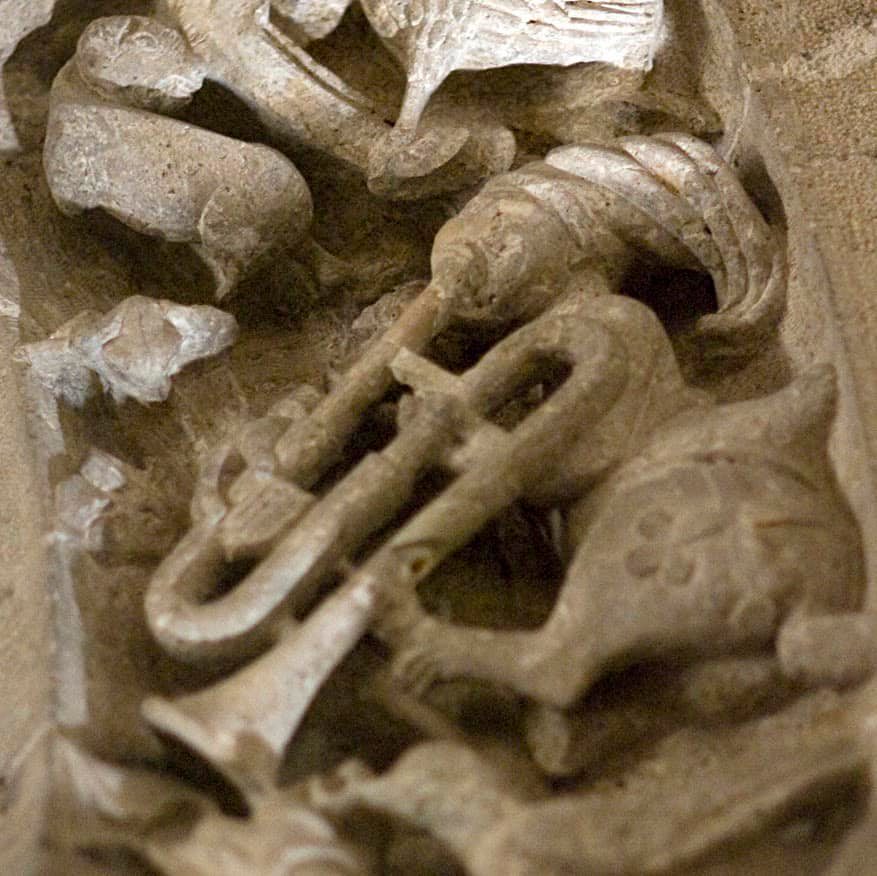
1484—Munich, Germany: Duke Albrecht IV employs a 4-part wind band consisting of 3 shawms and 1 trombone (Polk, German 101).
1484—Siena, Italy: Payment records from the civic wind band show the trombonist earning L. 28.10 per month and each of the 3 shawms earning L. 22.10 per month (D’Accone, Civic Muse 536).
1484/85—Bruges, Belgium: Trombonist Jan Fauset, a member of a prominent musical family from Leuven, Belgium, is appointed a member of the town wind ensemble (Polk, Susato 84).
1485—Gent, Belgium: The town wind band, originally a group of town “watchers,” expands from 4 to 5 players—3 shawms and 2 trombones (Polk, Susato 78).
1485—Brussels, Belguim: The civic wind ensemble expands to 4 players, including one trombonist (Polk, Susato 82).
1485—Siena, Italy: The civic wind band, including trombone, travels with an envoy to Rome to congratulate the new pope (Aeneas Sylvius Piccolomini) on his election (D’Accone, Civic Muse 532).
 1486—Bergen op Zoom (now Netherlands): A Flemish trombonist by the name of Josse Spillaert is employed with the town wind ensemble (Polk, Susato 91).
1486—Bergen op Zoom (now Netherlands): A Flemish trombonist by the name of Josse Spillaert is employed with the town wind ensemble (Polk, Susato 91).
1487—Siena, Italy: Geronimo di Giovanni, a trumpeter in the service of the Sienese palace since 1480, becomes one of several trumpeters to switch to trombone for a higher-paying pifferi post (D’Accone, Civic Muse 539).
1487—Naples, Italy: Music for a church service includes trombone (Hill, Emergence 343).
1487—Bologna, Italy: The wedding of Lucrezia, daughter of Duke Ercole of Ferrara to Annibale Bentivoglio, includes a wind ensemble of “100 trombita e 70 pifari e trombuni e chorni e flauti e tamburini e zamamele” (Whitwell, Before 203).
1487—Siena, Italy: A document reports that Francesco di Antonio is to make 7 silver trumpets and a silver trombone (D’Accone, Civic Muse 554).
1488—Augsburg, Germany: Renowned trombonist Augustein Schubinger is termed a trumeter in his own home town, highlighting the continuing ambiguity in terminology between trombone and trumpet (Polk, The Trombone).
1488—Kampen, the Netherlands: The town wind band, which consists of trombone and shawms, is required to play on “all Sundays and holy days, at the conclusion of Vespers, the lof in honor of Our Blessed Virgin, that is, two composed pieces and others as is ordinarily done” (Polk, Susato 90).
1488-91—Ferrara, Italy: Salary records from the duke of Ferrara’s court include 2 trombonists, “Piero” and “Zoanne.” At 288 LM per year, Piero is the single highest-paid musician in the court (Lockwood 183).
1488-93—Rome, Italy: In the Carafa Chapel of the church of Santa Maria sopra Minerva, the earliest reliable visual depiction of a trombone is painted: a fresco by Filippino Lippi entitled The Assumption of the Virgin (see detail and full image below; click on full image to expand; public domain) (Kurtzman, Trombe; Herbert, Susato 118; Partridge 118; Goldner 73).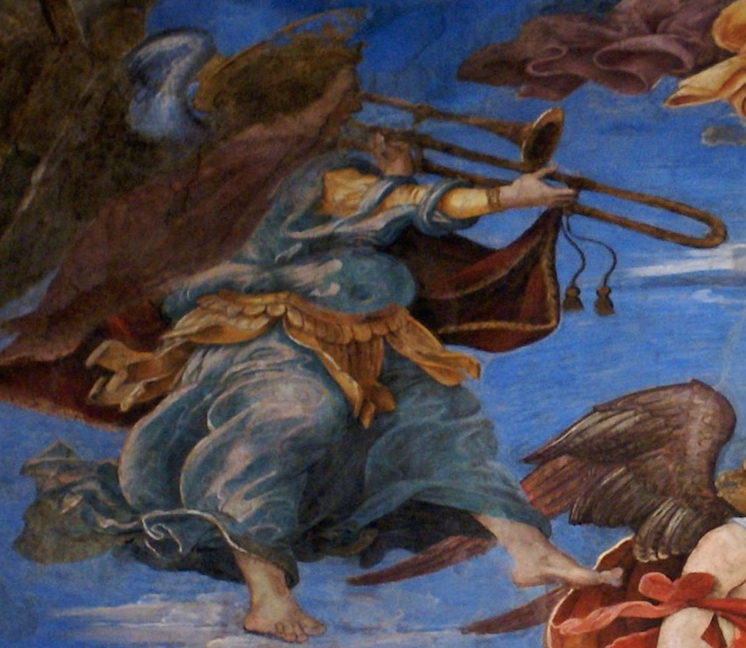
 c. 1489—Mantua, Italy: Bartolomeo Tromboncino arrives in Mantua to serve as trombonist for the wind band of the Duke of Mantua. Soon thereafter, Lorenzo de’ Medici offers him a similar post in Florence, which Tromboncino declines (see 1489, below). He later becomes a well-known frottola composer (Sanders, Gonzaga 33). Tromboncino is one of several musicians who adopt the name of their instrument as a surname, including Antonio da Cornetto, Girolamo Trombetti, and Alfonso della Viola (Reese 546). For more on Tromboncino’s personal life, see 1499, below.
c. 1489—Mantua, Italy: Bartolomeo Tromboncino arrives in Mantua to serve as trombonist for the wind band of the Duke of Mantua. Soon thereafter, Lorenzo de’ Medici offers him a similar post in Florence, which Tromboncino declines (see 1489, below). He later becomes a well-known frottola composer (Sanders, Gonzaga 33). Tromboncino is one of several musicians who adopt the name of their instrument as a surname, including Antonio da Cornetto, Girolamo Trombetti, and Alfonso della Viola (Reese 546). For more on Tromboncino’s personal life, see 1499, below.
1489—Florence, Italy: A trombone position in the Florence civic wind band becomes vacant and Lorenzo de Medici becomes personally involved in filling it, first with an unsuccessful offer to Mantuan trombonist Bartolomeo Tromboncino, then with a successful offer to German trombonist Augustein Schubinger (McGee, Service). Schubinger’s services are highly valued by the city, as reflected by his particularly high salary (Polk, Schubinger). He serves in Florence until 1493, whereupon he takes a post with the Habsburg court. During his time in Florence, Schubinger’s primary instrument changes from trombone to cornetto (Polk, Voices and Instruments).
1489—Nuremberg, Germany: The Nuremberg city council records the decision “to accept and appoint a new trombonist [Pusawner]” (Green, Defining).
1490—According to historian Keith Polk, “By at least 1490, then, outstanding trombone and cornetto players were performing liturgical music, with singers. Note that these were still probably individual players (sometimes two performers are mentioned). That is, the shawm ensemble was not yet incorporated as a unit into vocal performances. Furthermore, the players mentioned are, in a majority of cases, trombone players. That is, in the early transitional stages, as new practices evolved, trombonists (and trombonists doubling on cornetto) seem to have been the performers most observed and mentioned” (Polk, Schubinger).
1490—Venice, Italy: Alvise trombon is hired as a member of the Doge’s wind band, bringing the makeup of the ensemble to 3 piffari and 3 trombones. Records from the deliberation of the city government to hire Alvise say the following about his ability: “Alvise…is indeed, as everyone knows, superior to everyone else in the art of playing brass instruments” (Baroncini).
1490—Milan, Italy: At the Sforza court, a Festa del Paradiso is held in honor of Isabella d’Aragona. Shortly before the festa begins, “When everyone was seated, the piferi and trombones began to play. After they had played for a while, they stopped, and some tambourin players were ordered to play…” (Merkley 419).
1490—Milan and Ferrara, Italy: After a request from Ludovico Sforza, Ercole d’Este of Florence writes him that “Piero our trombonist will always be ready to teach Bartolomeo your trumpeter the manner and art of playing the trombone” (el modo et l’arte del sonar el trombono) (Prizer, Music at the Court of the Sforza).
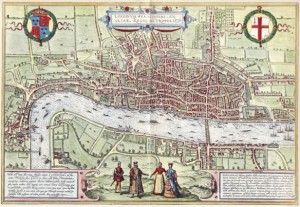 1490—London, England: Trombonist Hans Nagel begins service to the English crown, where he works until about 1506 (Polk, German 78).
1490—London, England: Trombonist Hans Nagel begins service to the English crown, where he works until about 1506 (Polk, German 78).
1490—Oudenaarde, Belgium: Jan Amilleur is appointed as “city sackbut,” where he serves until 1526 (Polk, Susato 88).
1492—Siena, Italy: Because of internal dissatisfaction within the Siena civic wind band (pifferi), an appeal is made to a special committee about how best to improve matters. The report from the committee says, in part, “…since you have only two pifferi who are really qualified, that is, the trombone [Girolamo] and Jacopo, and [since] Cristoforo piffero’s son Domenico, who equals them in knowledge, is available, the three of them can play together. We are certain they will bring you as much honor as any others in Italy because they’ll be able to learn to perform things that your other pifferi can neither play nor are capable of learning. For this reason we believe these three should not be stopped when they wish to perform [this other music]. Thus we wish, with your lordships’ permission, to be able to tell so and so not to play sometimes, especially when they want to perform things they do not know how to play” (D’Accone, Civic Muse 542).
1493—Nuremberg, Germany: The Nuremberg city council arranges “to give the city trombonists [pusawnern] new trombones [pusawnen] from the city, and…the same trombonists will then repair them at their own cost for the duration of their service” (Green, Defining).
1494—Ferrara, Italy: Ercole I d’Este, Duke of Ferrara, lends his wind band (pifferi and tromboni) to the French king, Charles VIII, at Pisa. Charles admires the players and pays a special gift of money to Piero Trombone (a trombonist) and a trumpet player (Lockwood 141).
1494—Venice, Italy: In a letter written by Giovanni Alvise, a city musician of Venice, Alvise discusses arrangements of motets by Obrecht and Busnois for wind band, specifically mentioning the trombone by name, and other parts by range only: “In these past days we have made instrumental arrangements of certain motets, of which I am sending two to your Lordship. One of these is a work of Obrecht, i.e. for four voices, two sopranos, a tenor and a ‘contra alto.’ And because we are six, I have added two bass parts to be played by trombones” (Polk, German 73, 85).
1494-5—Venice, Italy: A roster of the ducal wind band records the makeup of the band as 3 players labeled pifaro and 2 players labeled trombone (Alvixe de Zorzi and Jeronimo de Zorzi), in addition to Bortholamio de Zorzi (instrument not indicated). The roster is attached to the following payment indication: “The above players, who are of our most illustrious signoria, are our brothers, for whom they are obliged to play on the day of the feast and as a reward to have two candles, two loaves, and nothing else for each one” (Baroncini).
1494-97—Italy: Benedetto da Maiano’s high relief marble sculpture, The Coronation of Alfonso II, features what are probably 3 trombone players. Although the sculpture is badly damaged, a full trombone is visible in the hands of one of the brass players, and the embouchure and grip of another player are clearly visible. Noteworthy aspects of the rendering include the non-underhand left-hand grip of the 2 players, the relatively small size of the trombone (cf. Bellini detail—1496, below), and the banners apparently attached to the slides (cf. Aldegrever—1538 and Anonymous Nuremberg—c. 1550, 16th century) (see 2 details and wider view below; public domain) (Carl, Benedetto da Maiano 1:359). The sculpture is now held in Florence’s Museo Nazionale Bargello.

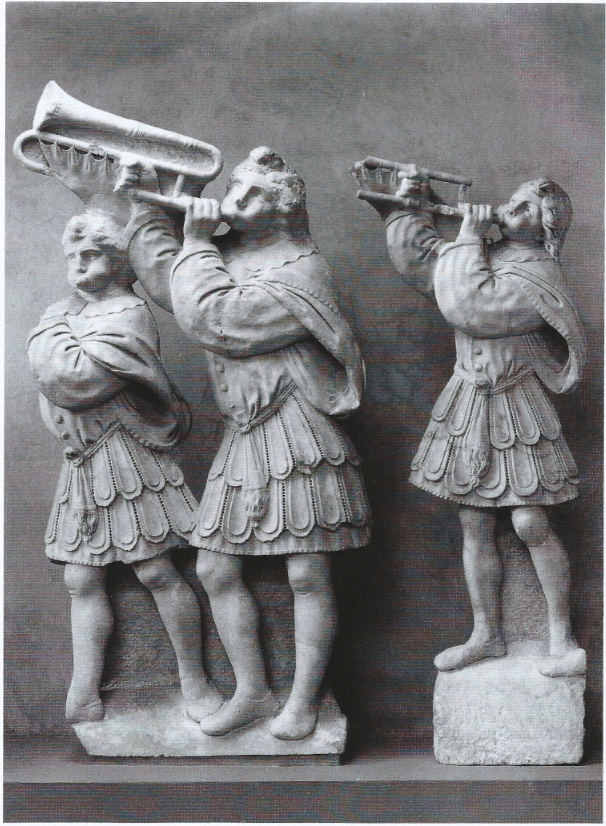
1495—England: One of the earliest documented uses of trombone in England is shown by a payment record: “To 4 Shakbushes for ther wags l7.0.0” (Herbert, Susato 118).
1495—Venice, Italy: A motet for 5 voices by Obrecht is performed, accompanied by 2 trombones (Galpin, Sackbut).
1495—Italy: Francesco Gonzaga takes his wind band of shawms and trombones with him into the Battle of Fornovo. The players apparently perform as signal instruments, for Gonzaga’s entertainment, and at a Mass celebrating the battle’s victory (Prizer, Isabella).
1496—Charles VIII again requests to borrow the pifferi and trombones of the Duke of Ferrara (see 1494, above), but this time the duke is unable to accommodate his request (Lockwood 141).
1496—Venice, Italy: In Gentile Bellini’s painting, Procession in Piazza San Marco, a lengthy procession includes a wind band with an instrument that appears to be an alto trombone. Given the early date, the image may simply represent an artist’s attempt at a trombone rather than a specific depiction of an alto trombone. It is also noted that the trombonist is clothed in red; historians have observed that color of dress in processions in general, and this procession in particular, is highly significant, highlighting an elaborate social hierarchy (Hills 173-178). A full view of Bellini’s painting shows the position of the wind band within a section of the procession (middle-right of image; click on image for larger version). Finally, the painting depicts an event said to have taken place approximately 50 years earlier—25 April 1444—when, during a procession on the square, Jacopo de’ Salis knelt before the relic (a fragment of the cross) in prayer that his dying son might recover, then, upon returning home, discovered that the boy was well again. Had the trombone been a cutting-edge, brand new musical instrument in 1496, it is somewhat unlikely that Bellini would have included it in a painting meant to depict events from half a century earlier (Venice, Accademia; public domain).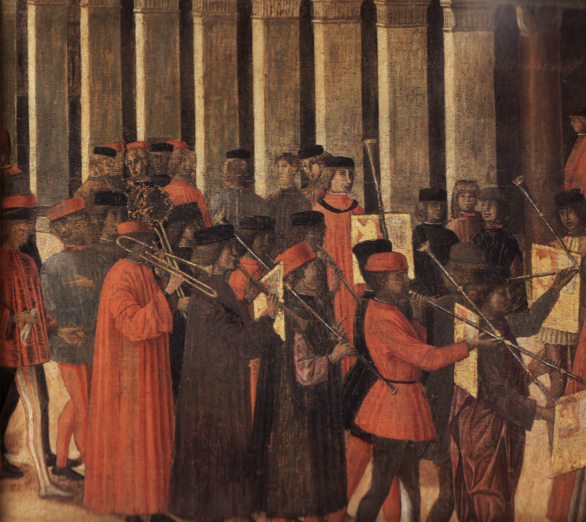

1497—Brescia, Italy: The Queen of Cyprus enters Brescia with a procession that includes an ensemble of 10 tromboni et piferi, in addition to a separate group of tamborini, stafeti, violete e lauti (Broder; Carver, Cori spezzati 2).
1497—Nuremberg, Germany: The city council grants trombonist Hans Neuschel his certificate as “master coppersmith and turner.” Neuschel is the earliest recorded maker of the trombone (Bate 134) and becomes founder of a long dynasty of brass manufacturers in Nuremberg (Clemenicic 18).
1498—Belgium and Holland: Philip the Fair hears the shawms and trombones in civic ensembles at Ghent, Bruges, Tournai, Maastricht, and Den Bos (Polk, Instrumental).
1499—Mantua, Italy: Court composer and trombonist Bartolomeo Tromboncino murders his wife. The circumstances of the murder are related in a letter from the patron Marchesa Isabella to her husband: “Today around five o’clock in the afternoon, Alfonso Spagnolo came to notify me that Trombonicino had killed his wife with great cruelty for having found her at home alone in a room with Zoanmaria de Triomfo, who was seen by Alfonso at the window asking him [Alfonso] to find a ladder; but, hearing noise in the house, [Alfonso] did not wait and went inside. He found Tromboncino, who had attacked his wife with weapons, climbing the stairs accompanied by [his] father and a boy. Although he [Alfonso] reprimanded him, Tromboncino replied that he had the right to punish his wife [if he] found her in error, and, not having arms, he [Alfonso] was unable to stop him, so that when he returned home for arms, she was already dead. Zoanmaria, in the middle of this, jumped from the window. Tromboncino then retreated to [the church of] S. Barnaba with the father and the boy. For myself, I wanted to tell the story to Your Excellency and to beg you that, having had legitimate cause to kill his wife, and being of such goodwill and virtue as you are, to have mercy on them, and also on the father and the boy, who, as far as Alfonso could tell, did not help Tromboncino in any way except to escape…” Trombonicino is never charged with any crime related to the murder (Atlas, Aragonese 350).
c. 1500—Söhlde, Nettlingen, Germany: A painting in the Evangelische Pfarrkirche St. Maria features an angel trombonist. See below image; public domain (Bildarchiv Foto Marburg).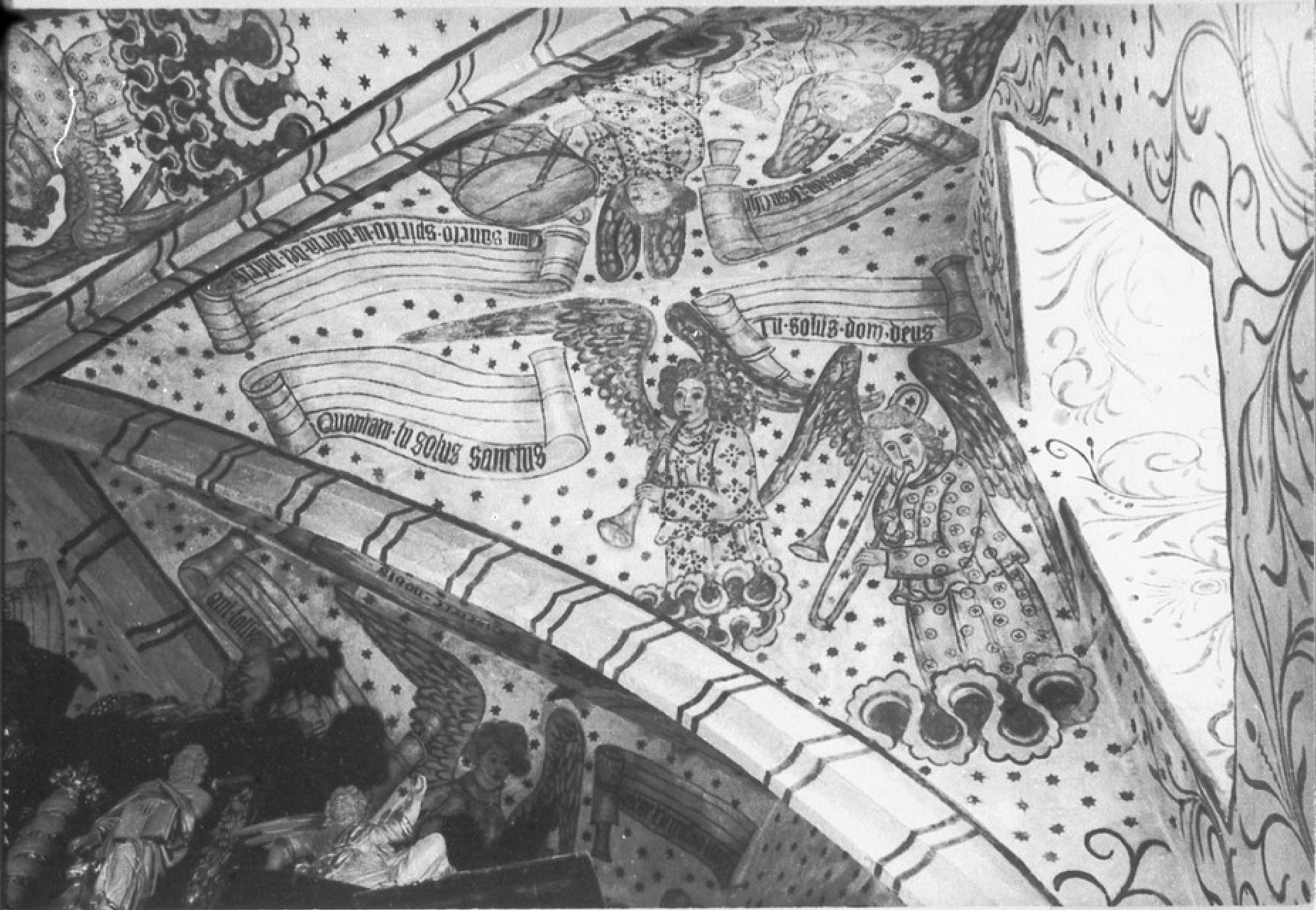
1500—France, Belgium, and Holland: Philip the Fair hears the shawms and trombones in civic ensembles at Béthune, St. Omer, Dunkirk, Nieuwpoort, Aalst, Dordrecht, Delft, and Bergen op Zoom (Polk, Instrumental).
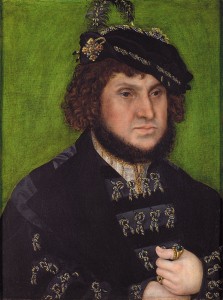 1500—Torgau, Germany: At the wedding festivities of John the Steadfast (Duke Johann) to Sofia of Mecklenburg, Adam von Fulda directs 2 Masses in the castle chapel, accompanied by organ, 3 trombones (dreyer posaun), a cornett, and 4 crumhorns (Reese 655; Boydell, The Crumhorn 16).
1500—Torgau, Germany: At the wedding festivities of John the Steadfast (Duke Johann) to Sofia of Mecklenburg, Adam von Fulda directs 2 Masses in the castle chapel, accompanied by organ, 3 trombones (dreyer posaun), a cornett, and 4 crumhorns (Reese 655; Boydell, The Crumhorn 16).
1500-1506—Bologna, Italy: Salary records of the instrumental ensemble Concerto Palatino name 12 musicians: 3 shawmists, 2 trombonists, 1 harpist, 5 trumpeters, and 1 player of nakers (Kurtzman, Trombe).
c. 1500—Mantua, Italy: Enrico Tedesco (also known as Ulrich Schubinger the Younger) appears on the court payroll as trombonist (Polk, Schubinger).
c. 1500—Munich, Germany: Court of Bavaria employs 2 shawm ensembles, each probably with its own trombonist (Polk, German 102).
1500-1525—Bergamo, Italy: A musician by the name of Martinus de Besutio has a career as a player of both trumpet and trombone. He is the first player known to have played in both the pifferi (town wind band) and the tubatori (herald trumpeters) (Towne).
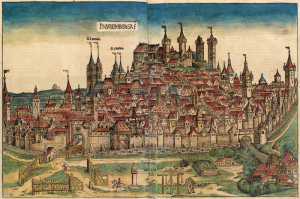 c. 1500-1533—Nuremberg, Germany: Trombonist Hans Neuschel the Younger (d. 1533) becomes the most renowned maker of brass instruments in the early 16th century (Kmetz, Economy 135).
c. 1500-1533—Nuremberg, Germany: Trombonist Hans Neuschel the Younger (d. 1533) becomes the most renowned maker of brass instruments in the early 16th century (Kmetz, Economy 135).
Late 1400s—Bologna, Italy: Ensembles consisting of 8 shawms and 8 trombones and cornettos give daily, hour-long performances in front of the city hall (Whitwell, Before 104).
Late 1400s—Mantua, Italy: Francesco of Mantua employs court pifferi consisting of 3 shawm players and 2 trombonists. A typically versatile group, they are said to have the ability to play many other wind and string instruments as well.
Late 1400s—Austria: Archduke Sigmund of Austria employs a shawm band, probably consisting of 3 shawms and 2 trombones. The ensemble is later inherited by Emperor Maximilian (Polk, German 90).
Late 1400s—According to Polk, “The trombone had been further refined—the bell was less flared, producing a more covered, blended sound which was a timbre particularly effective for working with voices, and with zincks and crumhorns. We know that the Nuremberg family of makers, the Neuschels, was credited at the time with some basic redesign of the instrument, and they may well have had a hand in this development.”

